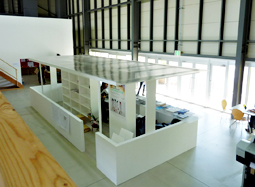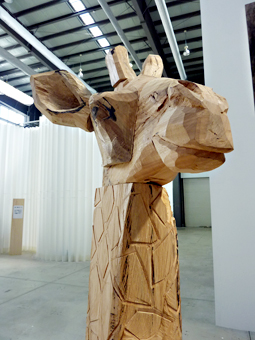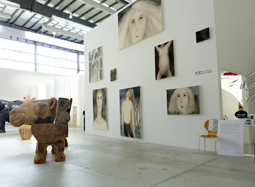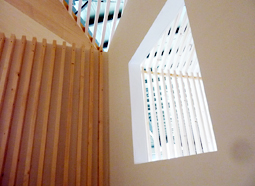 |
|
 |
| The Shin Minatomura reception counter by Mikan. All new construction in the exhibition is made of reused or scrap materials. |
|
Actors rehearse for their upcoming performance in the Shin Minatomura Theater, a free-form space by Takaharu Tezuka Study Lab with Yui Tezuka. The walls are of washi paper in giant accordion folds. |
This year marks the tenth anniversary since the founding of Yokohama Triennale, Japan's leading international contemporary art exhibition, which occurs every three years in the fall. For 2011 the number of participating venues has expanded to include not only the Yokohama Museum of Art and the NYK Waterfront Warehouse (BankArt Studio NYK) but also "tie-up" events in the Koganecho district and the new Shinko Pier Exhibition Hall. In addition to the basic exhibits that will be up for the duration of the Triennale, a number of autonomous events (such as rotating gallery exhibits, performances, lectures and talk sessions) are being put on by affiliated art initiatives and artists-in-residence programs.
The historic Shinko Pier is the site of an ambitious exhibition produced by BankArt 1929. The vision for Shin Minatomura (literally "New Harbor Village") is a prototype "small city for the future" built entirely within a 4,400-square-meter warehouse. Nearly all of the materials used to build the exhibition were scraps otherwise bound for disposal. To limit the use of imported electricity, a photovoltaic power generator and redox flow battery cell system were installed with the aim of an 85% reduction in energy consumption. Another lofty goal of Shin Minatomura is to interconnect Tohoku and Yokohama residents, which will, according to the program, create "a communal platform for their inhabitants, skills, commodities and energy sources." A weekly bus is bringing Tohoku residents back and forth to the Triennale site.
 |
|
 |
| Girls on a Rock by Mai Kobayashi, 2010. |
|
A life-size giraffe in wood by Kaede Sakurai. |
The exhibition is divided into four zones that represent a range of densities but maintain a human scale throughout. A long list of both established and emerging architects and artists has helped to create the displays and structures. The pavilions in the entry hall are simply clad with unadorned plywood panels and laid out orthogonally, mimicking an urban context. A mezzanine-level walkway allows visitors to look down into and engage with the spaces below. One of many structures by Yokohama-based architecture office Mikan is the elegant, flat-roofed reception counter.
Second in the sequence of exhibit halls is a dense zone of smaller-scale structures laid out organically in a neighborhood-like setting. Visitors can sense the buzz of a fully functioning marketplace that includes a post office, a shoe store, a barber and even a bicycle repair shop. Most of these structures were created by university labs or young designers, and offer charming little surprises around every corner. Just beyond this neighborhood is the civic center, with two large galleries, and the Shin Minatomura Theater, a free-form performance space set up by Tokyo City University's Takaharu Tezuka Study Lab with Yui Tezuka. As a venue it is not entirely isolated, visually or acoustically, from the adjacent spaces. Tezuka Architects is widely known for such recent projects as Fuji Kindergarten and Wall-less House. Perhaps in a nod to the venerable Japanese paper architect Shigeru Ban, Tezuka has created a sublime theater-in-the-round out of sturdy washi paper made rigid by giant accordion folds.
 |
|
 |
| A near-life-size elephant made of found industrial objects by Koro Ihara. |
|
Oil paintings by Akiko Kinugawa on the outer walls of the Shin Minatomura Gallery provide the backdrop for sculptures by Kaede Sakurai and Koro Ihara. |
Of the fine art currently on display at Shin Minatomura, sculpture and mixed media seem to predominate. A strictly Under 35 Gallery reflects the heavy participation of young artists, particularly those in their early twenties. A playful piece by the 24-year-old Nagoya artist Mai Kobayashi, entitled Girls on a Rock, beckons passersby from within its own display space. The work of Akiko Kinugawa (recently graduated from Musashino Art University) graces the outer walls of the Shin Minatomura Gallery as part of a rotating exhibit called Essential Ongoing [see "Here and There" in this issue for details]. Her ethereal depictions of women and animals transfix the viewer with their blank stares and provide a contrasting backdrop for several nearly life-size wild animal sculptures situated along the public circulation corridor. A horse and giraffe in wood can be credited to Kaede Sakurai (another recent Musashino graduate), while an elephant, hippo and cheetah by Koro Ihara (recently graduated from Tama Art University) are of metal and found industrial objects.
The scale shifts again in the final section, referred to as the residential zone. Here, seven distinct pavilions are situated around the perimeter of an open "free square" in the center. Small performance spaces, a bookstore and cafe enjoy a panoramic view of Yokohama Harbor, all but guaranteeing that this is where visitors will be inclined to linger. The cafe by Masao Koizumi of Koizumi Atelier is a lovely solid-and-void contrast that utilizes a restrained palate of white and natural pine framing. Because these pavilions are built within a warehouse, the designers have been able to test their concepts freely without having to consider drainage, water-tightness, building codes, the permit process and so many other buzz kills of "real architecture." While exhibitions like the Yokohama Triennale are fleeting, it is their temporality that encourages bold, innovative trials.
 |
|
 |
| Shin Minatomura Cafe, a pavilion-like structure made of recycled pine and bulk materials, by Koizumi Atelier/Masao Koizumi. |
|
A detailed view from inside the loft space over the Shin Minatomura Cafe by Koizumi Atelier/Masao Koizumi.
All photos by Nicolai Kruger with the permission of Shin Minatomura and BankArt 1929 |
|